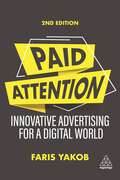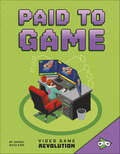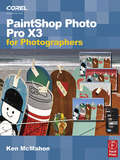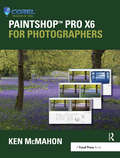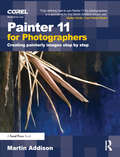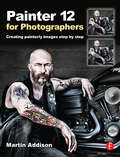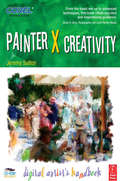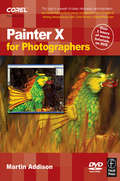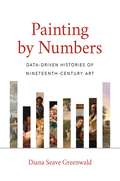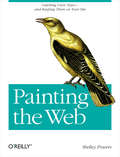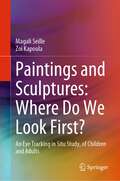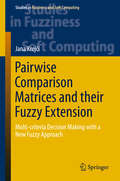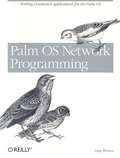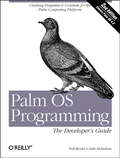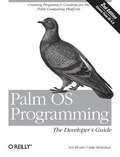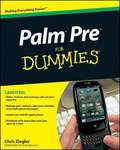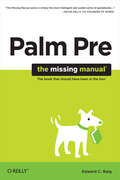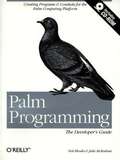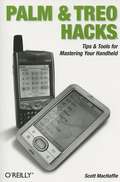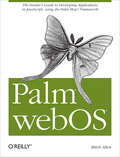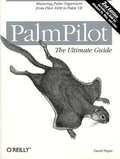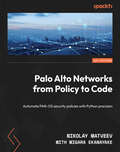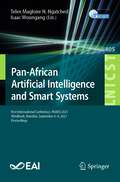- Table View
- List View
Paid Attention: Innovative Advertising for a Digital World
by Faris YakobThe advertising attention marketplace is a confusing and vast playing field where the rules have changed drastically over the last decade. Make yourself heard and win the attention of your target audience with the new edition of this ultimate guide.Paid Attention delivers new and innovative insights into advertising ideas: what they are, why they are evolving and how to use them in day to day strategy to ensure commercial stability within a changing digital landscape. Packed with real-world examples of advertising campaigns such as Google, Sony and Old Spice, it provides a robust model for influencing human behaviour and toolkits that offer best practice on brand behaviour and effective communication.This second edition includes two new chapters exploring the latest evidence about attention spans and trends in online advertising, as well as new case studies on compelling brand ideas. In a world where being a consumer is confusing, learn to take control of the situation and make yourself heard in today's crowded attention marketplace.
Paid to Game (Video Game Revolution)
by Daniel MauleónIn 2018 the gaming industry made over 100 billion dollars worldwide. Professional gamers, designers, programmers, and writers all received some of that money. Learn about the different jobs in video games, and maybe someday you'll get paid to game.
PaintShop Photo Pro X3 for Photographers
by Ken McMahonIf you are a digital photographer who's new to Paint Shop Pro Photo or digital imaging in general, or have recently upgraded to the all-new version XX, this is the book for you! Packed with full color images to provide inspiration and easy to follow, step-by-step projects, you'll learn the ins and outs of this fantastic program in no time so you can start correcting and editing your images to create stunning works of art. Whether you want to learn or refresh yourself on the basics, such as effective cropping or simple color correction, or move on to more sophisticated techniques like creating special effects, everything you need is right here in this Corel-recommended guide. Useful information on printing and organizing your photos and a fantastic supplemental website with tons of extras rounds out this complete PSPP learning package.
PaintShop Pro X4 for Photographers
by Ken McMahonGreat for those new to PaintShop Pro or digital imaging in general, this book is packed with inspirational, full-color images and easy to follow, step-by-step projects that will have you producing great images in PaintShop Pro in no time! Everything you need to turn your photos into stunning works of art is right here in this Corel-reviewed guide. In this new edition, Ken covers new features including how to make the most of the newly organized workspaces, use the redesigned HDR tool, and instantly publish photos on Flickr and Facebook. Squeeze every ounce of detail out of RAW files using the newly enhanced Camera RAW Lab and improve tonal range with the new Fill light/Clarity filter. This book has everything a photographer needs to take their photos to the next level with PaintShop Pro. Be sure to visit the companion website www.gopaintshoppro.co.uk for practice files, bonus tutorials and other fabulous resources.
PaintShop Pro X6 for Photographers
by Ken McMahonWritten for photographers of all levels, PaintShop Pro X6 for Photographers is packed with inspirational, full-color images and easy-to-follow step-by-step projects that will have you producing great images in PaintShop Pro in no time! Everything you need to enhance and improve your digital photography is right here in this Corel® endorsed guide. In this new edition, Ken McMahon looks at the pros and cons of the new, faster 64-bit version of the software and covers new features, including working with the Instant Effects palette, using the Smart selection brush, mapping photos, automatically tagging people, and uploading to Facebook, Flickr, and Google+. Other program features—selections, masking, layers, adjustments and effects, HDR, and scripting—are explained through practical examples that are just as relevant for older versions of the software. This book has everything a photographer needs to take their photos to the next level with PaintShop Pro. Learn from PaintShop Pro expert Ken McMahon with the most authoritative book on PaintShop Pro endorsed by Corel®. Completely revised and updated with all of the new features in X6—get up to speed with 64-bit processing power, new selection tools, workspace enhancements, and much more. A complete learning package with full-color screen shots and examples, and step-by-step projects at the end of each chapter.
Painter 11 for Photographers: Creating painterly images step by step
by Martin AddisonWhether you are new to Painter or a seasoned pro wanting to take your digital art to the next level, this inspirational book and DVD package will show you how to get the most out of Corel's powerful painting software.Starting with the basics and moving on to cover brushes, textures, cloning, toning and other effects, Martin Addison will help you master the tools and features needed to transform your photographs into stunning works of art. Over 2 hours of video tutorials and clear, step-by-step examples take you through the techniques in a no-nonsense manner, with all images provided on the accompanying DVD so you can learn by doing. Packed with beautiful images to illustrate what can be achieved with the right skills and know-how, Painter XI For Photographers will inspire you to get creative with your personal or commercial photographs.
Painter 12 for Photographers: Creating painterly images step by step
by Martin AddisonTransform your photographs into stunning works of art with this fully updated, authoritative guide to the all-new Painter 12. Whether you are new to Painter or a seasoned pro wanting to go further with your digital art, Painter 12 for Photographers will show you how to get the most of Corel's powerful painting software. Starting with the basics and moving on to cover brushes, textures, cloning, toning, and other effects, Martin Addison will help you master the techniques needed to transform photographs into beautiful painterly images. Packed with vivid images to illustrate what can be achieved with the right skills and know-how, Painter 12 for Photographers will inspire you to get creative with your photographs.
Painter X Creativity: Digital Artist's handbook
by Jeremy SuttonEmpower your artistry in the digital environmentThis unique Painter book addresses both creative and technical proficiency, helping you step ahead in today's world of photography, art, multimedia, and design. This lavishly illustrated guide speaks directly to all visual artists and shows you how to combine traditional and stateof-the-art media to capture the essence of your vision.Fully updated for Corel Painter X and the newest range of Wacom graphics tablets, progressive, well-structured tutorials from beginner to advanced level, case studies, and examples of art will inspire your imagination at every stage. Let world-renowned Painter master Jeremy Sutton guide you step-by-step in how to experiment with creative ideas and techniques that you can adapt to your own style.New time-saving tips, workflow strategies, and keyboard short cuts allow you to quickly transform your work with Corel Painter X's outstanding natural-media tools. From expressive paintings to evocative collage portraits, oil impressionism, live portrait paintings, and painterly effects for video, television, and the Web, you get the best techniques through...*Clear explanations with colorful screen grabs and inspiring artworks that lead youthrough the sophisticated and creative Painter tools*Practical, hands-on tutorials, and project illustrations that show you every step inimage development, including multimedia artist techniques*A CD-ROM packed with unique custom brushes, tutorial images, and additional artmaterials not supplied with Painter XIncluded on the resource CD:*48 extra brushes including many unique custom brushes not supplied with Painter *38 custom color sets*Jeremy's SupaDoopa custom palettes to help speed up your workflow*Collection of Jeremy's favorite Image Hose nozzles, paper textures, and patterns to greatly enhance the variety and richness of art materials available at your fingertips*Gain instant access to Jeremy's interface customization and optimize your creativity with unique custom workspaces, new to Painter X*4 QuickTime movies including a studio tour, artwork commentary, and details on Wacom tablets*Have fun practicing with 28 tutorial images!
Painter X for Photographers: Creating Painterly Images Step by Step
by Martin AddisonWhether you are just starting out with Painter, or are a seasoned pro who wants to take your photographs to the next level, you can't go wrong with this essential guide by your side! Covering Painter X, but also applicable to earlier versions and to both PC and Macintosh users, this reader friendly book and DVD package will show you how to get the most out of this powerful program. Uniquely written specifically for photographers, Martin Addison gives a complete overview of the program, showing how to master each exciting tool, including the brand-new RealBristle and Smart Stroke brush libraries. Two all-new portraiture chapters show you how to turn photographs of your family members or professional clients into works of art ideal for framing. You'll be able to give all of your precious photographs the painterly touch in no time! Be sure to visit the accompanying website www.painterforphotographers.co.uk to view even more images and information to get you started! Pictures by Martin and Doreen Addison can be seen on their website: www.martinanddoreen.co.uk.
Painting by Numbers: Data-Driven Histories of Nineteenth-Century Art
by Diana Seave GreenwaldA pathbreaking history of art that uses digital research and economic tools to reveal enduring inequities in the formation of the art historical canonPainting by Numbers presents a groundbreaking blend of art historical and social scientific methods to chart, for the first time, the sheer scale of nineteenth-century artistic production. With new quantitative evidence for more than five hundred thousand works of art, Diana Seave Greenwald provides fresh insights into the nineteenth century, and the extent to which art historians have focused on a limited—and potentially biased—sample of artwork from that time. She addresses long-standing questions about the effects of industrialization, gender, and empire on the art world, and she models more expansive approaches for studying art history in the age of the digital humanities.Examining art in France, the United States, and the United Kingdom, Greenwald features datasets created from indices and exhibition catalogs that—to date—have been used primarily as finding aids. From this body of information, she reveals the importance of access to the countryside for painters showing images of nature at the Paris Salon, the ways in which time-consuming domestic responsibilities pushed women artists in the United States to work in lower-prestige genres, and how images of empire were largely absent from the walls of London’s Royal Academy at the height of British imperial power. Ultimately, Greenwald considers how many works may have been excluded from art historical inquiry and shows how data can help reintegrate them into the history of art, even after such pieces have disappeared or faded into obscurity.Upending traditional perspectives on the art historical canon, Painting by Numbers offers an innovative look at the nineteenth-century art world and its legacy.
Painting the Web: Catching the User's Eyes - and Keeping Them on Your Site
by Shelley PowersDo you think that only professionals with expensive tools and years of experience can work with web graphics? This guide tosses that notion into the trash bin.Painting the Web is the first comprehensive book on web graphics to come along in years, and author Shelley Powers demonstrates how readers of any level can take advantage of the graphics and animation capabilities built into today's powerful browsers. She covers GIFs, JPEGs, and PNGs, raster and vector graphics, CSS, Ajax effects, the canvas objects, SVG, geographical applications, and more -- everything that designers (and non-designers) use to literally paint the Web. More importantly, Shelley's own love of web graphics shines through in every example. Not only can you master the many different techniques, you also can have fun doing it. Topics in Painting the Web include:GIF, JPEG, PNG, lossy versus lossless compression, color management, and optimization Photo workflow, from camera to web page, including a review of photo editors, workflow tools, and RAW photo utilities Tricks for best displaying your photos online Non-photographic raster images (icons and logos), with step-by-step tutorials for creating popular "Web 2.0" effects like reflection, shiny buttons, inlays, and shadows Vector graphics An SVG tutorial, with examples of all the major components Tips and tricks for using CSS Interactive effects with Ajax such as accordions and fades The canvas object implemented in most browsers Geographical applications such as Google Maps and Yahoo Maps, with programming and non-programming examples Visual effects such as forms and data displays in table or graphics Web design for the non-designer Graphics are not essential to the web experience, but they do make the difference between a site that's functional and one that's lively, compelling, and exciting. Whether you want to spruce up a website, use photos to annotate your stories, create hot graphics, or provide compelling displays for your data, this is the book for you.
Paintings and Sculptures: An Eye Tracking in Situ Study, of Children and Adults
by Magali Seille Zoi KapoulaThe book presents three studies in which eye tracking data were collected at the Musée des Beaux-Arts in Rouen in June and July 2013. Overall, the results of those three studies highlight the knowledge gained from the analysis of the very first saccade in a museum context, when people look at paintings and statues. The first study analyzes how viewers orient their first saccade on paintings. This study shows that, in a museum, the first saccade is attracted toward the center of paintings. This attraction toward the paintings’ center is found in all the subjects’ groups that we have studied. Noteworthily, this effect is significantly less pronounced in individuals who never visit museums. It is among amateurs, who often visit museums, that the center attracts the most the first saccade. Among experts, painters or art history teachers, and to a lesser extent among amateurs, the pictorial composition largely determines the orientation of the first saccade. We indeed found that, as soon as the first saccade, experts orient their gaze toward the main subject. This phenomenon seems to be explained by the fact that experts immediately orient their gaze (here measured as the first saccade) toward the paintings’ location conveying the most meaning. It can either be the center, or a peripheral area, depending on whether the paintings’ most meaningful subject is located centrally or peripherally. The second study shows that the center does not attract the first saccade in 5-year-old children. This behavior appears later, in 8- to 10-year-old children. However, noticeably, the 8–10-year-old children orient significantly less frequently their first saccade toward the paintings’ center as adults do, and this is also true when one considers non-expert adult viewers. The results of the third study focus on statues and reveal a very different oculomotor behavior: Indeed, rather than looking at the center, statues’ viewers exhibit a clear tendency to saccade first at the statues’ contours. This stands in contrast with the behavior that we observe with paintings. Our study concludes that statues trigger a specific oculomotor behavior. The latter appears to be mostly driven by the physical presence that stone bodies incarnate. The movement and the climax of this movement, that sculptors manage to convey, thus turn out to attract the gaze in a unique fashion. The book concludes that the first saccade is a powerful indicator of the oculomotor behavior that greatly improves our comprehension of the unique relationship between a viewer and artworks.
Pairwise Comparison Matrices and their Fuzzy Extension: Multi-criteria Decision Making With A New Fuzzy Approach (Studies in Fuzziness and Soft Computing #366)
by Jana KrejčíThis book offers the first comprehensive and critical literature review of fuzzy pairwise comparison methods derived from methods originally developed for crisp pairwise comparison matrices. It proposes new fuzzy extensions of these methods and provides a detailed study of the differences and analogies between all the reviewed methods, as well as a detailed description of their drawbacks, with the help of many numerical examples. In order to prevent the drawbacks related to the reviewed fuzzy pairwise comparison methods, the book introduces constrained fuzzy arithmetic in fuzzy extension of the pairwise comparison methods. It proposes new fuzzy pairwise comparison methods based on constrained fuzzy arithmetic and critically compares them with the reviewed methods. It describes the application of the newly developed methods to incomplete large-dimensional pairwise comparison matrices showcased in a real-life case study. Written for researchers, graduate and PhD students interested in multi-criteria decision making methods based on both crisp and fuzzy pairwise comparison matrices, this self-contained book offers an overview of cutting-edge research and all necessary information to understand the described tools and use them in real-world applications.
Palm OS Network Programming
by Greg WintonJust in time for the wireless revolution comes the first complete guide to creating network applications for the Palm computing platform. Palm OS Network Programming covers the Palm Net Library and networking concepts such as transport protocols and client-server applications. Abundant examples illustrate how the many Palm-specific nuances relate to effective Palm network programming, so you learn to build truly well-designed connected Palm applications.
Palm OS Programming: The Developer's Guide
by Neil Rhodes Julie McKeehanWith more than 16 million PDAs shipped to date, Palm has defined the market for handhelds, having dominated this class of computing devices ever since it began to outpace competitors six years ago. The company's strength is the Palm OS, and developers loyal to this powerful and versatile operating system have created more than 10,000 applications for it. Devices from Handspring, Sony, Symbol, HandEra, Kyocera, and Samsung now use Palm OS, and the number of registered Palm Developers has jumped to 130,000.If you know C or C++, and want to join those who are satisfying the demand for wireless applications, then Palm OS Programming: The Developer's Guide, Second Edition is the book for you. With expanded coverage of the Palm OS--up to and including the latest version, 4.0--this new edition shows intermediate to experienced C programmers how to build a Palm application from the ground up. There is even useful information for beginners.Everything you need to write a Palm OS application is here, from user interface design, to coding a handheld application, to writing an associated desktop conduit. All the major development environments are discussed, including commercial products such as Metroworks CodeWarrior, Java-based environments such as Sun KVM and IBM VisualAge Micro Edition, and the Free Software Foundation's PRC-Tools or GCC. The focus, however, is C programming with CodeWarrior and PRC-Tools. New additions to the second edition include:A tutorial that takes a C programmer through the installation of necessary tools and the creation of a small handheld application.A new chapter on memory, with a comprehensive discussion of the Memory Manager APIs.Greatly expanded discussions of forms, forms objects, and new APIs for the Palm OS.Updated chapters on conduits that reflect the newer Conduit Development Kit.The best-selling first edition of this book is still considered the definitive guide for serious Palm programmers; it's used as the basis of Palm's own developer training materials. Our expanded second edition promises to set the standard for the next generation of Palm developers.
Palm OS Programming: The Developer's Guide, 2nd Edition
by Julie Mckeehan Neil RhodesPalm OS Programming: The Developer's Guide , Second Edition shows intermediate to experienced C and C++ programmers how to build a Palm application from the ground up. The book follows up the success of our best-selling first edition with expanded coverage of the Palm OS, up to and including the latest version, 4.0. This book will set the standard for the next generation of Palm developers.
Palm Pre For Dummies
by Chris ZieglerEverything you need to know to make the most of Palm's newest smartphone Smartphones provide all sorts of communication options as well as the ability to manage your appointments and contacts. If you're new to smartphones, Palm Pre For Dummies gets you up and running easily. If you're a bit more savvy, you can delve deeper into more advanced elements, such as Synergy contact management and working with media. The Palm Pre offers features that make it a top contender in the smartphone market. Its webOS system is designed for a touchscreen-based graphical user interface that facilitates many exciting new features. Palm Pre is a new smartphone specifically engineered for a touchscreen device and loaded with features to maximize the user experience This book helps you take advantage of GPS navigation, games on your phone, and media management Begins with the basics: turning the phone on, making and receiving calls, and storing contacts Covers applications for managing personal information and how Palm Synergy helps manage your communications Shows you how to manage and synchronize e-mail accounts, use the calendar, take advantage of Web site resources, and install new webOS applications Palm Pre For Dummies helps you take full advantage of this new feature-rich device.
Palm Pre: The Missing Manual (Missing Manual)
by Ed BaigIf you've got your hands on this year's hottest new smartphone, you'll want the book that covers it inside and out: Palm Pre: The Missing Manual. This beautiful, full-color book from USA Today personal-technology columnist Ed Baig will help you go from newcomer to expert in no time. The maker of the legendary Palm Pilot is back on center stage with a smartphone that lets you browse the Web, listen to music, watch video, view pictures, and a lot more. Palm Pre: The Missing Manual provides you with everything you need to know to get the most out of this amazing mobile tool. Get to know the touchscreen, and learn to navigate by tapping, swiping, dragging, flicking, and pinching Link your contacts, merge calendars, combine email accounts, and more by syncing your phone over the Web Stay in touch with other people by using the Pre as a full-featured phone and organizer Use it for email, texting, chatting, and as an efficient web browser Take advantage of the Pre as a complete media center to store, sort, play, stream music and video, and sync with iTunes Take and view photos, import images, and share them with others
Palm Programming: The Developer's Guide
by Julie Mckeehan Neil RhodesPalmPilot's popularity is growing and with over a million units sold, the Palm OS dominates the hand-held market. Wired has astutely described Palm's position in a recent article: "On its way to becoming the bestselling hand-held computer of all time, the 3Com PalmPilot has spawned an intense, emotional, and fanatical developer following not seen since the glory days of the Mac." (Wired, 20 Feb. 98). Palm Programming should be eagerly accepted by programmers because the authors worked closely with Palm to ensure that the book is tailored exactly to the needs of the ever-growing group of Palm developers. As nothing but some piecemeal documentation exists currently, this book provides a much needed solution to the Palm developers. In fact, Palm uses this book as their official developer's guide and will be using it in the future as a key part of their training materials for developers. There are currently no books on Palm programming (and we know of none that are planned). The only way to learn is by using the reference material published by Palm (available freely on their Web site), the tutorial they provide, or various Palm programming FAQs compiled by third parties. Palm Programming shows intermediate to experienced C programmers how to build a Palm application from the ground up. Using an easy-to- understand tutorial approach, this book gives readers everything necessary to create a wide range of Palm applications and conduits, from simple scripts through full-blown applications, and in the process provides thorough coverage of Palm programming. It includes a CD-ROM (Macintosh and Windows compatible) with the full source code to the examples in the book, a trial version of Palm's Software Development Kit, and third-party developer tools, including Metrowerks' CodeWarrior Lite programming kit. Outline Part 1: Overview of Palm OS and devices Chapter 1: The Palm Solution Chapter 2: Developing for Palm OS Chapter 3: Designing a solution Part 2: Programming for the handheld Chapter 4: Structure of an Application Chapter 5: Forms and Form Objects Chapter 6: Databases Chapter 7: Menus Chapter 8: Extras Chapter 9: Communications Chapter 10: Debugging Part 3: Programming for the desktop: conduits Chapter 11: Getting started with conduits Chapter 12: Uploading and Downloading Data Chapter 13: Two-way Syncing Appendix: Where to go from here
Palm and Treo Hacks
by Scott MachaffiePalm OS is one of the most popular handheld operating systems on the planet. From the newest Tungstens and Treos all the way down the family tree, Palms are everywhere. Although the Palm OS is simple to learn and use, there is more to it than meets the eye--from new features in the Palm to capabilities you can get with add-on software, the Palm can be made to do quite a lot. Palm and Treo Hacks gives you tips and tools that show you how to make the most of your Palm. A few minutes spent reading some of the hacks in this book will save you hours of research. Inside this book, you'll learn how to: Find great applications for your Palm and make the most of the ones you're using now Get super-organized, getting more from the built-in Personal Information Manager and learning how to manage complex projects with your Palm Extend the Palm with must-have software and hardware add-ons Take your Palm online, reading email, surfing the web, and sending instant messages Get some rest and relaxation with your Palm, whether it's listening to music, playing classic games, or watching video Written for beginning to experienced Palm users, Palm and Treo Hacks is full of practical, ingenious tips and tricks you can apply immediately. Whether you're looking to master the built-in applications or you want to trick out your Palm to its fullest extent, this book will show you how to get it.
Palm webOS: The Insider's Guide to Developing Applications in JavaScript using the Palm Mojo™ Framework (Animal Guide)
by Mitch AllenA Note from the Author and from O'Reilly Media about what this book does--and doesn't--do: Palm webOS is a brand new platform and represents a very different type of operating system where the web runtime is used as the basis for the UI and Application model. Palm and O'Reilly felt that it was important to have a book available to help developers get a basic understanding of the new Palm platform at the time that the SDK was released; this timing played a major role in the content and structure of the book. Ideally this book would have been a complete reference of the new platform but that wasn't possible since the content was written at the same time as the software SDK was being developed by the Palm engineering team. The book does provide a complete overview of Palm webOS, a thorough description of the application model and gives details on many key design concepts. There are descriptions and examples of UI widgets, services, storage, notifications, dashboards and background applications, serving as a great introduction but not as a definitive source. The book uses a simple News reader application to illustrate the technical descriptions but the examples are not intended to serve as a cookbook tutorial. Experienced developers should be able to use the examples to build up a working application chapter by chapter but others may not find the loose descriptions adequate for recreating the application unaided. Over time, these different needs will be filled by other books, but in the meantime we hope that this book will serve a valuable role introducing developers to webOS and giving them a way of getting started with webOS application development. A second printing of the book will update any original coverage obsoleted by subsequent Mojo SDK builds. For owners of the original printing of the book, all of these updates are posted on the "View/Submit Errata" link (please see left-hand column of this web page). Thanks for understanding that book publishing and coverage of rapidly moving technologies can sometimes be an inexact science; we knew there'd be a need for a book such as Palm webOS: The Insider's Guide to Developing Applications in JavaScript using the Palm MojoT Framework, and there's certainly no better person to write that book that Mitch Allen; that said, we understand that because it is such a new operating system and SDK, there would (and will continue to be) changes that at best can't be documented and explored until new printings of the books are released. In the meantime we will be diligent in posting updates to this book's O'Reilly Media catalog page. Description This is the official guide to building native JavaScript applications for Palm's new mobile operating system, Palm® webOSTM. Written by Palm's software chief technology officer along with the Palm webOS development team, Palm webOS provides a complete tutorial on the design principles, architecture, UI, tools, and services necessary to develop webOS applications-including the Mojo JavaScript framework and Palm's SDK. Palm webOS is designed to support a fast and superb user experience using established web standards, so if you're familiar with HTML, CSS, and JavaScript, you're ready to build applications for any webOS-based device, including the Palm Pre. You'll gain expertise, chapter by chapter, as you build a working mobile application through the course of the book. You'll also learn how to extend existing web apps to work with the new generation of mobile phones. Get a thorough overview of the webOS platform and architecture Understand the critical concepts for application design: what separates webOS from other web and mobile platforms Learn the details of Mojo's development tools and SDK for building and testing mobile applications Examine best practices, important considerations, and guiding principles for developing with webOS and the Mojo framework
PalmPilot: The Ultimate Guide, 2nd Edition
by David PogueThis new edition of O'Reilly's runaway bestseller is densely packed with previously undocumented information. The bible for users of Palm VII and all other Palm models, it delivers hundreds of timesaving tips and surprising tricks, plus an all-new CD-ROM (for Windows 9x, NT, or Macintosh) containing over 3,100 PalmPilot programs from the collection of palmcentral.com, the Internet's largest Palm software site.
Palo Alto Networks from Policy to Code: Automate PAN-OS security policies with Python precision
by Nikolay Matveev Migara EkanayakeCreate automated security policies for Palo Alto Networks firewalls that transform manual processes into scalable, code-based solutionsKey FeaturesStreamline security policy deployment using Python and automation toolsLearn how PAN-OS processes and secures enterprise network trafficImplement automated security actions for real-time threat mitigationGet With Your Book: PDF Copy, AI Assistant, and Next-Gen Reader FreeBook DescriptionPalo Alto Networks firewalls are the gold standard in enterprise security, but managing them manually often leads to endless configurations, error-prone changes, and difficulty maintaining consistency across deployments. Written by cybersecurity experts with deep Palo Alto Networks experience, this book shows you how to transform firewall management with automation, using a code-driven approach that bridges the gap between powerful technology and practical implementation. You’ll start with next-gen firewall fundamentals before advancing to designing enterprise-grade security policies, applying threat prevention profiles, URL filtering, TLS decryption, and application controls to build a complete policy framework. Unlike other resources that focus on theory or vendor documentation, this hands-on guide covers best practices and real-world strategies. You’ll learn how to automate policy deployment using Python and PAN-OS APIs, structure firewall configurations as code, and integrate firewalls with IT workflows and infrastructure-as-code tools. By the end of the book, you’ll be able to design, automate, test, and migrate firewall policies with confidence, gaining practical experience in quality assurance techniques, pilot testing, debugging, and phased cutovers—all while maintaining security and minimizing business impact.What you will learnMaster next-generation firewall fundamentalsDesign enterprise-grade security policies for the Internet gatewayApply App-ID, URL filtering, and threat preventionAutomate policy deployment using Python, PAN-OS APIs, SDKs, and IaC toolsCustomize response pages with Jinja2 and integrate them into service desk workflowsTest and validate with QA techniques and pilot testingMigrate policies with confidence and zero downtimeWho this book is forThis book is for firewall engineers, security engineers, consultants, technical architects, and CISOs who want to enhance their network security expertise through Policy as Code on Palo Alto Networks firewalls. It's also perfect for those with working knowledge of Python programming and hands-on experience with Palo Alto Networks' Next-Gen firewalls, whether in business, government, or education. This book will help network engineers, security architects, and DevSecOps professionals simplify firewall management and reduce operational overhead.
Palo Alto: A History of California, Capitalism, and the World
by Malcolm HarrisNamed One of the Year's Best Books by VULTURE • THE NEW REPUBLIC • DAZED • WIRED • BLOOMBERG • ESQUIRE • SALON • THE NEXT BIG IDEA CLUBThe history of Silicon Valley, from railroads to microchips, is an &“extraordinary&” story of disruption and destruction, told for the first time in this comprehensive, jaw-dropping narrative (Greg Grandin, Pulitzer Prize-winning author of The End of the Myth). Palo Alto&’s weather is temperate, its people are educated and enterprising, its corporations are spiritually and materially ambitious and demonstrably world-changing. Palo Alto is also a haunted toxic waste dump built on stolen Indian burial grounds, and an integral part of the capitalist world system. In PALO ALTO, the first comprehensive, global history of Silicon Valley, Malcolm Harris examines how and why Northern California evolved in the particular, consequential way it did, tracing the ideologies, technologies, and policies that have been engineered there over the course of 150 years of Anglo settler colonialism, from IQ tests to the "tragedy of the commons," racial genetics, and "broken windows" theory. The Internet and computers, too. It's a story about how a small American suburb became a powerful engine for economic growth and war, and how it came to lead the world into a surprisingly disastrous 21st century. PALO ALTO is an urgent and visionary history of the way we live now, one that ends with a clear-eyed, radical proposition for how we might begin to change course.
Pan-African Artificial Intelligence and Smart Systems: First International Conference, PAAISS 2021, Windhoek, Namibia, September 6-8, 2021, Proceedings (Lecture Notes of the Institute for Computer Sciences, Social Informatics and Telecommunications Engineering #405)
by Isaac Woungang Telex Magloire N. NgatchedThis book constitutes the refereed post-conference proceedings of the First International Conference on Pan-African Intelligence and Smart Systems, PAAISS 2021, which was held in Windhoek, Namibia, in September 2021. The 17 revised full papers presented were carefully selected from 41 submissions. The theme of PAAISS 2021 was “Advancing AI research in Africa” and the papers are arranged according to subject areas: Deep Learning; Classification and Pattern Recognition; Neural Networks and Support Vector Machines; Smart Systems.
